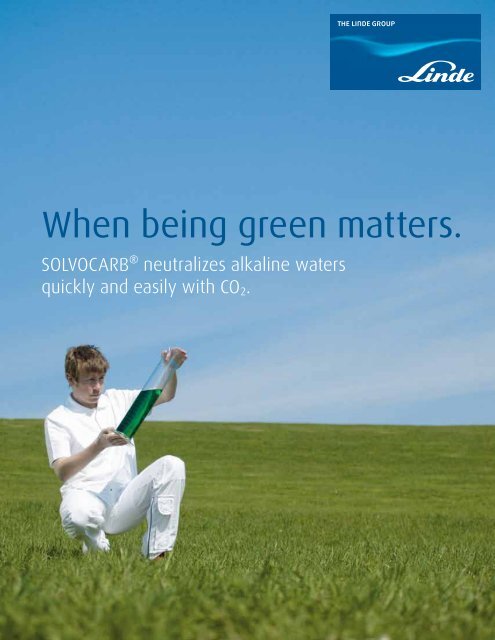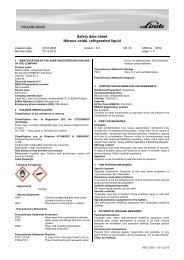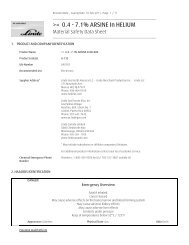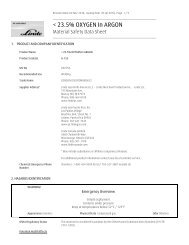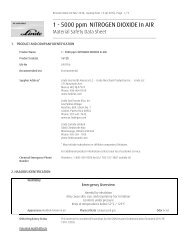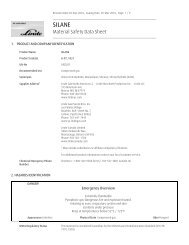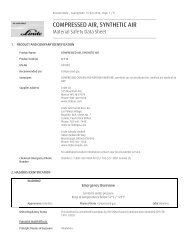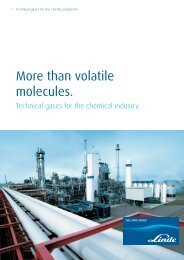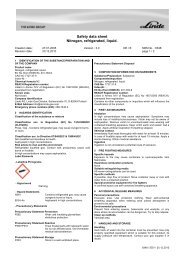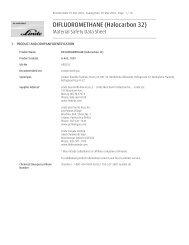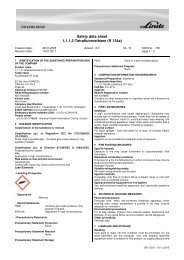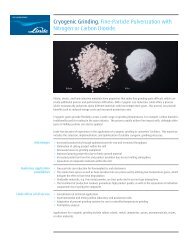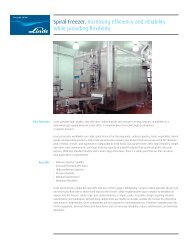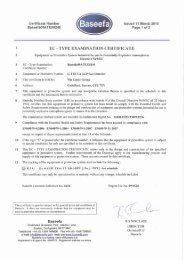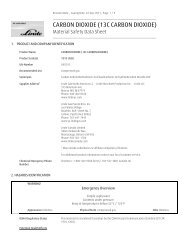When Being Green Matters - CO2 pH Control - Linde North America
When Being Green Matters - CO2 pH Control - Linde North America
When Being Green Matters - CO2 pH Control - Linde North America
You also want an ePaper? Increase the reach of your titles
YUMPU automatically turns print PDFs into web optimized ePapers that Google loves.
<strong>When</strong> being green matters.<br />
SOLVOCARB® neutralizes alkaline waters<br />
quickly and easily with CO 2 .
02 SOLVOCARB®<br />
For the environment’s sake. Recently, the increased<br />
concern for environmental responsibility and<br />
sustainability has led to stricter regulations and<br />
frequent audits from various organizations. The <strong>pH</strong><br />
value of wastewater, for instance, may only deviate<br />
minimally from the neutral point when discharged<br />
into a receiving watercourse (such as a river or a<br />
lake) or into a sewage system. Injecting carbon<br />
dioxide is the best way to neutralize alkalinity<br />
while also reducing environmental stress.<br />
SOLVOCARB® is a registered trademark of the <strong>Linde</strong> Group.
No excessive acidification, less corrosion<br />
Carbon dioxide is increasingly used to neutralize alkaline wastewater.<br />
<strong>When</strong> dissolved in water, carbon dioxide forms carbonic acid which has<br />
many advantages compared to mineral acids, such as:<br />
→→<br />
preventing the excessive accumulation of salts<br />
such as chlorides and sulphates.<br />
→→<br />
preventing the excessive acidification of wastewater<br />
due to the buffering capacity of carbon dioxide.<br />
→→<br />
eliminating the safety risks of highly corrosive acids.<br />
Safe supply<br />
CO 2 is stored in pressure vessels as a liquid at 300 psig. It is converted to<br />
a gas at ambient temperatures before use. As CO 2 is a neutral gas until<br />
dissolved in water, this eliminates the requirements for eyewash stations<br />
and safety showers that are necessary with mineral acids. Furthermore,<br />
the application of CO 2 eliminates the risk of a harmful acid spill.<br />
Multiple Applications<br />
Additionally, carbon dioxide is so ecofriendly and safe that it even<br />
adjusts swimming pool water to the obligatory upper limit of <strong>pH</strong> 7.5. More<br />
commonly, however, carbon dioxide is used to neutralize alkaline process<br />
waters in many industries including:<br />
→→<br />
Beverage<br />
→→<br />
Dairies and butcheries<br />
→→<br />
Bakery and confectionery<br />
→→<br />
Electroplating<br />
→→<br />
Cement and concrete<br />
→→<br />
Paper and cellulose<br />
→→<br />
Leather<br />
→→<br />
Textile<br />
→→<br />
Laundries and dye works<br />
→→<br />
Photo-chemical
Dairies and butcheries<br />
Dairies in particular, which generate a highly<br />
biodegradable effluent, produce alkaline and<br />
acidic wastewaters where the <strong>pH</strong> can vary<br />
between 4.5 and 10. They are pre-neutralized<br />
in buffer tanks and only then is SOLVOCARB®<br />
used to neutralize the excess alkalis.<br />
Beverage industry<br />
Cleaning returnable bottles produces<br />
wastewater with a high alkaline concentration.<br />
After the washing process, the wastewater <strong>pH</strong><br />
value can reach up to 11. Before the filling<br />
process, the bottles must be rinsed. To avoid<br />
lime deposits accumulating on the bottle<br />
surface during this process, the <strong>pH</strong> value must<br />
be reduced.<br />
Textile industry<br />
In the textile industry, the mercerization<br />
process is used on cotton and sometimes<br />
on cotton blends to increase luster (thus<br />
also enhancing the appearance), to improve<br />
strength, and to improve their affinity for<br />
dyes. The process involves immersion under<br />
tension in a caustic soda (sodium hydroxide)<br />
solution, which is later neutralized using the<br />
SOLVOCARB® system.<br />
Leather industry<br />
The particular challenge consists in how to<br />
combine traditional leather production with a<br />
process not harmful to the environment while<br />
improving the hide quality. The solution is to<br />
apply SOLVOCARB® during the deliming process,<br />
eliminating acid shock risks, reducing<br />
nitrogenous discharge in the effluent and also<br />
reducing ammonia gas in the plant.<br />
Pulp and paper industry<br />
Whether deinking or bleaching or at the<br />
headbox – at every production step, the paper<br />
and pulp industries require exact <strong>pH</strong> values.<br />
Injecting carbon dioxide with SOLVOCARB®<br />
ensures precise results, due to a flat<br />
neutralization curve.<br />
Concrete industry, cement works<br />
and construction sites<br />
Concrete itself produces alkaline wastewaters.<br />
Carbon dioxide required for the neutralization<br />
of wastewaters from concrete production or<br />
construction sites ranges from 3–4.5 lbs/1000<br />
gallons wastewater. In the concrete industry,<br />
further applications of carbon dioxide are<br />
possible to prevent lime scaling in the<br />
wastewater pumps or calcification on the<br />
concrete surface or mature concrete.<br />
Laundries and dye works<br />
The washing waters of laundries and the dyeing<br />
solutions of dye works are alkaline with <strong>pH</strong><br />
values up to 12. Before discharge, the waters<br />
must be neutralized.<br />
Electroplating<br />
Most (metal) surface treatment and plating<br />
operations involve surface cleaning or<br />
preparation with solvents, alkaline cleaners,<br />
acid cleaners, abrasive materials and/or water.<br />
The used cleaning water can be neutralized<br />
with SOLVOCARB®.<br />
Combining our technical know-how with<br />
standard technologies, <strong>Linde</strong> is able to provide<br />
tailored solutions to each customer:<br />
• Static mixers<br />
• Venturi systems<br />
• Sintered matter<br />
• Diffusers
SOLVOCARB®<br />
05<br />
Clever solution<br />
The application of absorption varies depending on the properties of gas<br />
and liquid. The more soluble the gas, the less energy and equipment are<br />
required. As can be explained with the Henry-Dalton law and Fick’s first<br />
law, dissolving gas in water is determined by five different parameters:<br />
• Mass transfer coefficient, k<br />
• Liquid saturation concentration of gas, C* H • p i<br />
• Actual concentration of gas in liquid, C<br />
• Interface between gas and liquid, A<br />
• Contact time between gas and liquid, t<br />
Together these parameters describe the dissolution of gases<br />
in water as follows:<br />
Absorbed gas<br />
Minor investment<br />
k • (C*- C) • A • t<br />
[m/s]<br />
[mg/l]<br />
[mg/l]<br />
[m2]<br />
[s]<br />
Carbon dioxide dissolved in water forms carbonic acid. Due to the<br />
chemical properties of carbonic acid, carbon dioxide acts rapidly<br />
and effectively, without overshoot or localized areas of low <strong>pH</strong>.<br />
Excessive accumulation of salts and excessive acidification do not<br />
occur; neutralization to a target <strong>pH</strong> rapidly occurs with less hysteresis.<br />
Due to these well-balanced properties, neutralization with carbon<br />
dioxide maintains a consistent <strong>pH</strong> more easily, thus minimizing human<br />
intervention and reducing the costs of operation and maintenance while<br />
also increasing reliability.<br />
This buffer capacity of a water is called alkalinity – it is defined as the<br />
capability of water to prevent a <strong>pH</strong> change when adding acid or a base.<br />
Alkalinity is equal to the concentration of bicarbonate HCO 3 - ,<br />
carbonate CO 3 2- or hydroxyl OH - ions (table 2). To define a water’s<br />
phenolpthalein alkalinity, i.e. hydroxyl alkalinity, we use phenolphthalein<br />
as an indicator. Methyl orange is also used to define a water’s carbonate<br />
alkalinity and bicarbonate alkalinity.<br />
Process effluents with hydroxyl alkalinity can be neutralized with a<br />
standard recirculation system with pumps. If the effluent has carbonate<br />
alkalinity, or scale problems caused by high hardness, the carbon dioxide<br />
should be dissolved via bottom frames.<br />
There are three ways of determining the CO 2 requirement:<br />
• If data from a complete water analysis is available, we use a computer<br />
program to determine the exact requirement.<br />
• <strong>Linde</strong>'s <strong>North</strong> <strong>America</strong>n Technical Center is equipped to perform CO 2<br />
titrations. We also have simple sample mailing kits available.<br />
• If there is a well-known mineral acid consumption, we can estimate<br />
the demand of carbon dioxide based on a stoichiometric conversion<br />
such as seen in table 1.<br />
Compared to other acids, carbon dioxide neutralizes waters at a very<br />
low consumption rate. In many cases, the amount of CO 2 required for<br />
neutralization is significantly less than the amount of a mineral acid<br />
required to perform the same neutralization. This is shown in Table 1. This<br />
is because waste-water usually contains buffer substances that make it<br />
necessary to use more acid.<br />
Table 1:<br />
Relative usage of common acids (pound per pound)<br />
Acid MW Equivalent<br />
Weight<br />
Purity* Pounds to =<br />
1 pound CO 2<br />
CO 2 44 44 99.98 1<br />
H 2 SO 4 98 48 93 1.18<br />
Sulfuric Acid<br />
HCI 36.5 36.5 35 2.37<br />
HNO 3 63 63 90** 1.58<br />
* Purity listed is most common US industrial grades.<br />
Most mineral acids are sold as mixtures with water<br />
** “Strong” nitric acid…Techncial grade (70%) is also widely sold.
06 SOLVOCARB®<br />
Major balance<br />
Most of the carbon dioxide in aqueous solutions takes the form of<br />
dissolved gas. A small proportion of the carbon dioxide is converted into<br />
carbonic acid by this reaction (CO 2 + H 2 O ⇌ H 2 CO 3 ). At high <strong>pH</strong> values,<br />
carbonic acid discharges two protons which then participate in the<br />
neutralization process. However, only one proton is discharged at <strong>pH</strong><br />
values below 9. Although the neutralization process is continuous, there<br />
are three distinguishable chemical phases.<br />
First phase (<strong>pH</strong> > 11.8)<br />
H 2 CO 3 + 2NaOH ⇌ Na 2 CO 3 + 2 H 2 O<br />
Carbonate (CO 3 2- ) ions predominate in this phase.<br />
Second phase (8.3 < <strong>pH</strong> < 11.8)<br />
H 2 CO 3 + Na 2 CO 3 ⇌ 2NaHCO 3<br />
The percentage of hydrogen carbonate (HCO 3 - ) increases as the <strong>pH</strong> value<br />
falls. The crucial advantage: bicarbonates are much more eco-compatible<br />
than the salts of stronger acids. Moreover, non-toxic carbon dioxide is<br />
non-inflammable, easy to handle, and safe to store. Thus, it is currently<br />
the most eco-friendly way of neutralizing alkaline wastewaters.<br />
Third phase (<strong>pH</strong> < 8.3)<br />
In the third phase, the percentage of free dissolved carbon dioxide<br />
continues to increase as the neutralization curve levels out. Below <strong>pH</strong> 5,<br />
almost all the carbon dioxide is in a physically dissolved state. The third<br />
phase is usually not reached because the <strong>pH</strong> value required by law is<br />
higher than this.<br />
Table 2: Neutralization curves of caustic soda solution<br />
using carbon dioxide and a mineral acid<br />
Permissible range CO 2 Mineral acid<br />
14<br />
12<br />
10<br />
<strong>pH</strong> value<br />
8<br />
6<br />
4<br />
2<br />
0<br />
Phase I<br />
2 OH - + CO 2<br />
⇌ CO 3<br />
2-<br />
+ H 2 O<br />
Phase II<br />
CO 3<br />
2-<br />
+ CO 2 + H 2 O<br />
⇌ 2 HCO 3<br />
-<br />
Phase III<br />
Absorbed quantity of CO 2 and/or mineral acid
SOLVOCARB®<br />
07<br />
One technology, three options. SOLVOCARB® injects<br />
carbon dioxide either via hose, reactor, or nozzle.<br />
In each situation, this ensures the appropriate<br />
process for neutralizing alkaline wastewater<br />
and process waters – with mobile or stationary<br />
equipment, in industry or in wastewater treatment<br />
plants, in equalizing tanks or in pressure pipes.
08 SOLVOCARB®<br />
SOLVOCARB®-B<br />
The SOLVOCARB®-B process neutralizes alkaline waters in lagoons or<br />
buffer tanks. The gas diffuser hoses inject carbon dioxide uniformly<br />
into the water, thereby ensuring optimum utilization. Fixed at the<br />
bottom of the neutralizing tank, the perforated hoses are made of<br />
resistant elastomer. <strong>When</strong> the carbon dioxide is switched on, the<br />
pores open and small bubbles of gas are emitted. The carbon dioxide<br />
is injected without requiring an additional energy source, and is<br />
controlled by a <strong>pH</strong> measurement.<br />
SOLVOCARB®-B process.
SOLVOCARB®<br />
09<br />
SOLVOCARB®-R<br />
In the SOLVOCARB®-R process, carbon dioxide dissolves in the<br />
wastewater by means of a reactor and can be inserted in the main<br />
flow or in a bypass flow. Made of plastic, these reactors are usually<br />
operated at a pressure up to 90 psig gauge. The maximum operating<br />
temperature is 110°F. Stainless steel reactors can be used for higher<br />
temperatures or pressures.<br />
SOLVOCARB®-R process.
010 SOLVOCARB®<br />
SOLVOCARB®-D<br />
The SOLVOCARB®-D process uses a nozzle to inject carbon dioxide into<br />
a pipeline. However, when dissolving in wastewater, carbon dioxide<br />
requires a certain reaction distance after the supply point. This<br />
reaction distance can be significantly reduced by installing a static<br />
mixer.<br />
SOLVOCARB®-D process.
SOLVOCARB®<br />
011<br />
Success through diversity. Each facility is unique –<br />
SOLVOCARB® is uniquely flexible. The neutralization<br />
of alkaline wastewater and process waters plays<br />
a major role in many industrial sectors. Therefore,<br />
SOLVOCARB® systems are applicable in many different<br />
industries: from the food to the clothing industry, from<br />
electroplating to photochemistry, from the construction<br />
to the printing industry, and so many more …
Getting ahead through innovation.<br />
With its innovative concepts, <strong>Linde</strong> is playing a pioneering role in the global market. As a technology leader, it is our task<br />
to constantly raise the bar. Traditionally driven by entrepreneurship, we are working steadily on new high-quality products<br />
and innovative processes.<br />
<strong>Linde</strong> offers more. We create added value, clearly discernible competitive advantages, and greater profitability.<br />
Each concept is tailored specifically to meet our customers’ requirements – offering standardized as well as customized<br />
solutions. This applies to all industries and all companies regardless of their size.<br />
If you want to keep pace with tomorrow’s competition, you need a partner by your side for whom top quality, process<br />
optimization, and enhanced productivity are part of daily business. However, we define partnership not merely as being<br />
there for you but being with you. After all, joint activities form the core of commercial success.<br />
<strong>Linde</strong> – ideas become solutions.<br />
<strong>Linde</strong> <strong>North</strong> <strong>America</strong>, Inc.<br />
575 Mountain Ave., Murray Hill, NJ 07974 USA<br />
Phone +1.800.755-9277, sales.lg.us@linde.com, www.lindeus.com, www.lindewatertreatment.com<br />
1940_1112<br />
<strong>Linde</strong> <strong>North</strong> <strong>America</strong> Inc. is a member of The <strong>Linde</strong> Group. <strong>Linde</strong> is a trading name used by companies within the <strong>Linde</strong> Group. The <strong>Linde</strong> logo is a trademark of The <strong>Linde</strong> Group. © The <strong>Linde</strong> Group 2012.


